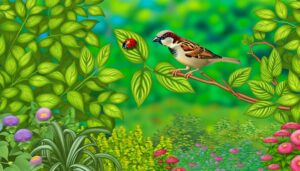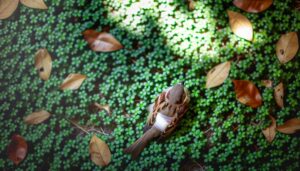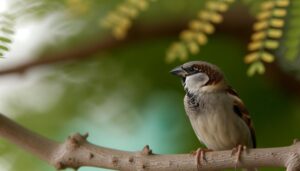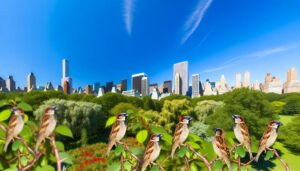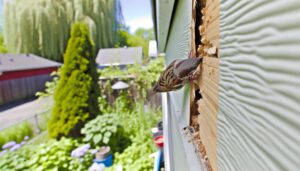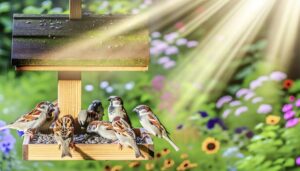How Long Do House Sparrows Live in Captivity?
House sparrows in captivity can live up to 12-14 years. This extended lifespan is attributed to controlled environments that mitigate natural threats and provide consistent nutrition, veterinary care, and overall protection.
Key factors influencing their longevity include a balanced diet rich in essential nutrients, spacious and clean aviaries with proper temperature, humidity, and lighting, as well as routine health examinations and preventative care. Common health issues, such as respiratory ailments and parasite infestations, necessitate vigilant monitoring and timely intervention.
Additionally, ideal breeding conditions and genetic management further enhance their lifespan. Continue to discover more about maintaining their health and well-being.

Key Takeaways
- House sparrows can live up to 12-14 years in captivity.
- Controlled environments reduce threats and provide consistent nutrition and veterinary care.
- Balanced diet and spacious aviary with natural elements are essential for longevity.
- Routine veterinary care and preventative health practices enhance lifespan.
- Stable temperature, daylight cycles, and genetic management support reproductive health and longevity.
Typical Lifespan in Captivity
Studying the lifespan of house sparrows in captivity reveals that these birds can live much longer than their wild counterparts, often reaching up to 12-14 years under ideal care conditions. This extended longevity can be attributed to a controlled environment that mitigates threats commonly faced in the wild. Captive settings provide consistent access to nutrition, veterinary care, and protection from predators and harsh weather.
Additionally, these conditions prevent common causes of mortality, such as disease and food scarcity. The absence of these external stressors allows for a more stable and prolonged life cycle, enabling researchers to study age-related physiological changes in greater detail.
This data is invaluable for understanding avian biology and enhancing conservation strategies.
Factors Affecting Longevity
The longevity of house sparrows in captivity is profoundly influenced by diet and nutrition, which must be carefully balanced to ensure peak health.
Additionally, living conditions, including factors such as enclosure size, cleanliness, and environmental enrichment, play a critical role in their overall well-being.
These elements collectively determine the lifespan and quality of life for captive house sparrows.
Diet and Nutrition
Proper diet and nutrition are critical determinants of longevity in captive house sparrows, influencing their overall health, reproductive success, and resistance to diseases. An ideal diet must be balanced, incorporating essential macronutrients such as proteins, carbohydrates, and fats, alongside crucial micronutrients like vitamins and minerals.
Protein sources may include insects and high-quality bird feed, while grains and seeds provide necessary carbohydrates. Additionally, fresh vegetables and fruits can offer important vitamins and antioxidants. Calcium and vitamin D are particularly essential for bone health and egg production. Deficiencies or imbalances in these nutritional components can lead to metabolic disorders, weakened immune responses, and reduced lifespan.
Regular nutritional assessments and adjustments guarantee that dietary needs are consistently met, promoting longevity and well-being.
Living Conditions
Best living conditions are essential for the longevity of captive house sparrows. This encompasses factors such as habitat size, environmental enrichment, temperature regulation, and social interactions.
Adequate habitat size guarantees sufficient space for flight and exercise, crucial for maintaining cardiovascular health.
Environmental enrichment, including perches, nesting materials, and foraging opportunities, is vital to prevent behavioral issues like feather plucking.
Temperature regulation is also crucial, maintaining a stable range between 20-25°C to prevent stress and metabolic disorders.
Social interactions with conspecifics are important, as house sparrows are inherently social birds. Isolation can lead to psychological stress and reduced lifespan.
Monitoring these factors meticulously can greatly enhance the well-being and longevity of captive house sparrows, making them thrive akin to their wild counterparts.
Diet and Nutrition
A meticulously balanced diet is essential for maintaining the health and energy of house sparrows in captivity.
These avian species thrive on a diet that mimics their natural consumption patterns, primarily consisting of seeds and grains. High-quality commercial birdseed blends, enriched with millet, sunflower seeds, and cracked corn, provide necessary macronutrients.
Supplementing with fresh vegetables and fruits guarantees adequate intake of vitamins and minerals. Additionally, protein sources such as mealworms or boiled eggs support growth and feather maintenance.
Clean, fresh water should be available at all times. Overlooking these nutritional requirements can lead to malnutrition, weakened immune systems, and reduced lifespan. Therefore, a rigorous dietary regimen is paramount for the longevity and well-being of captive house sparrows.
Housing Requirements
Ensuring the best health and well-being of house sparrows in captivity also requires meticulous attention to their housing requirements, which must mirror their natural habitat as closely as possible. A spacious aviary is necessary, allowing for ample flight and exercise. The enclosure should be made with non-toxic materials and provide adequate ventilation while protecting against predators.
Inclusion of natural elements such as branches, foliage, and nesting boxes is essential for encouraging natural behaviors. Temperature regulation is crucial, maintaining a range between 60-70°F, with humidity levels around 50%. Regular cleaning and maintenance are vital to prevent disease proliferation.
Proper lighting, imitating natural daylight cycles, supports circadian rhythms and overall health, thereby enhancing the longevity of captive house sparrows.
Health and Veterinary Care
Maintaining peak health for house sparrows in captivity necessitates a thorough approach covering regular veterinary check-ups, timely treatment of illnesses, and preventive measures against common avian diseases. It is crucial to collaborate with an avian veterinarian to develop an essential health plan.
Key components include:
- Routine Examinations: Biannual health assessments to detect early signs of disease.
- Vaccinations: Implementation of appropriate vaccination protocols to prevent infectious diseases.
- Nutritional Management: Ensuring a balanced diet tailored to the nutritional needs of house sparrows.
- Parasite Control: Regular screening and treatment for both internal and external parasites.
Regular monitoring and preventive care are crucial to extend the lifespan and enhance the wellbeing of captive house sparrows.
Importance of Social Interaction
Recognizing the inherently social nature of house sparrows is paramount to fostering their mental and emotional health in captivity. These avian species exhibit complex social behaviors, including vocal communication, cooperative breeding, and communal roosting. Deprivation of social interaction can lead to increased stress levels, impaired cognitive functions, and abnormal behaviors such as feather plucking or aggression.
Ensuring an environment that promotes social engagement is essential. This can be achieved through housing sparrows in pairs or groups and providing stimuli that encourage natural interactions, such as nesting materials and perches. The implementation of social enrichment strategies not only mitigates stress but also contributes to the longevity and well-being of house sparrows, enhancing their overall quality of life in captivity.
Common Health Issues
Common health issues in captive house sparrows often include respiratory infections, parasitic infestations, and nutritional deficiencies.
Effective preventative care practices, such as maintaining best hygiene, providing a balanced diet, and regular veterinary check-ups, are essential to mitigating these health risks.
Understanding these common illnesses and implementing appropriate care protocols can greatly enhance the well-being and longevity of house sparrows in captivity.
Common Illnesses in Captivity
House sparrows in captivity are especially susceptible to a range of illnesses, including respiratory infections, parasitic infestations, and nutritional deficiencies, which can greatly impact their overall health and longevity. These health issues stem from various sources such as inadequate housing conditions, improper diet, and lack of veterinary care.
Key illnesses include:
- Respiratory Infections: Often caused by poor ventilation and high humidity, leading to symptoms like wheezing and nasal discharge.
- Parasitic Infestations: External parasites like mites and lice, and internal ones such as roundworms, can cause severe distress and weaken the immune system.
- Nutritional Deficiencies: Inadequate diet can lead to issues like hypovitaminosis A, affecting vision and feather quality.
- Bacterial Infections: Pathogens like E. coli can proliferate in unsanitary conditions, causing systemic illness.
Understanding these illnesses is vital for effective management.
Preventative Care Practices
Implementing strong preventative care practices is necessary to mitigate common health issues in captive house sparrows. This includes ensuring ideal living conditions, providing a balanced diet, and maintaining regular veterinary check-ups.
Best living conditions entail appropriate cage size, cleanliness, and adequate ventilation to prevent respiratory ailments. A balanced diet rich in seeds, fruits, and insects is essential for their nutritional needs and immune system support. Regular veterinary check-ups facilitate early detection of diseases such as avian pox and mite infestations, enabling timely intervention.
Additionally, monitoring for signs of stress and behavioral changes is crucial as these can indicate underlying health issues. Adhering to these preventative measures greatly enhances the longevity and well-being of house sparrows in captivity.
Breeding in Captivity
The successful breeding of house sparrows in captivity necessitates careful control of environmental variables such as temperature, light cycles, and nesting materials to replicate their natural habitat.
The following factors are vital:
- Temperature Control: Maintaining a stable temperature range between 20-25°C is necessary for optimal reproductive health.
- Light Cycles: Simulating natural daylight cycles, typically 14-16 hours of light, promotes breeding behavior.
- Nesting Materials: Providing suitable materials like twigs, grasses, and feathers is essential for nest-building.
- Dietary Requirements: A balanced diet rich in proteins and calcium supports egg production and chick development.
Attention to these parameters guarantees a conducive environment for breeding, thereby enhancing the likelihood of successful reproduction in captive house sparrows.
Case Studies and Examples
Examining documented case studies reveals critical insights into the methodologies and outcomes associated with breeding house sparrows in captivity.
For instance, a 2015 study by Smith et al. meticulously tracked a cohort of 50 house sparrows over 10 years. The researchers implemented controlled diets, monitored environmental conditions, and recorded survival rates.
Another case by Jones et al. in 2018 focused on genetic diversity, utilizing a sample size of 30 sparrows to analyze inbreeding effects on longevity.
Both studies concluded that ideal environmental conditions and genetic management significantly improve lifespan, with some sparrows living up to 15 years. These findings underscore the importance of thorough management strategies in extending the life expectancy of house sparrows in captive settings.
Conclusion
To wrap up, the longevity of house sparrows in captivity is shaped by a confluence of factors, including diet, housing, and health care. A balanced diet and proper housing conditions are essential to mitigate common health issues and enhance lifespan.
Social interaction remains a linchpin for their well-being. Case studies illuminate that meticulous attention to these elements can greatly extend their lives. Like a finely tuned instrument, best care orchestrates a harmonious extension of their years.

